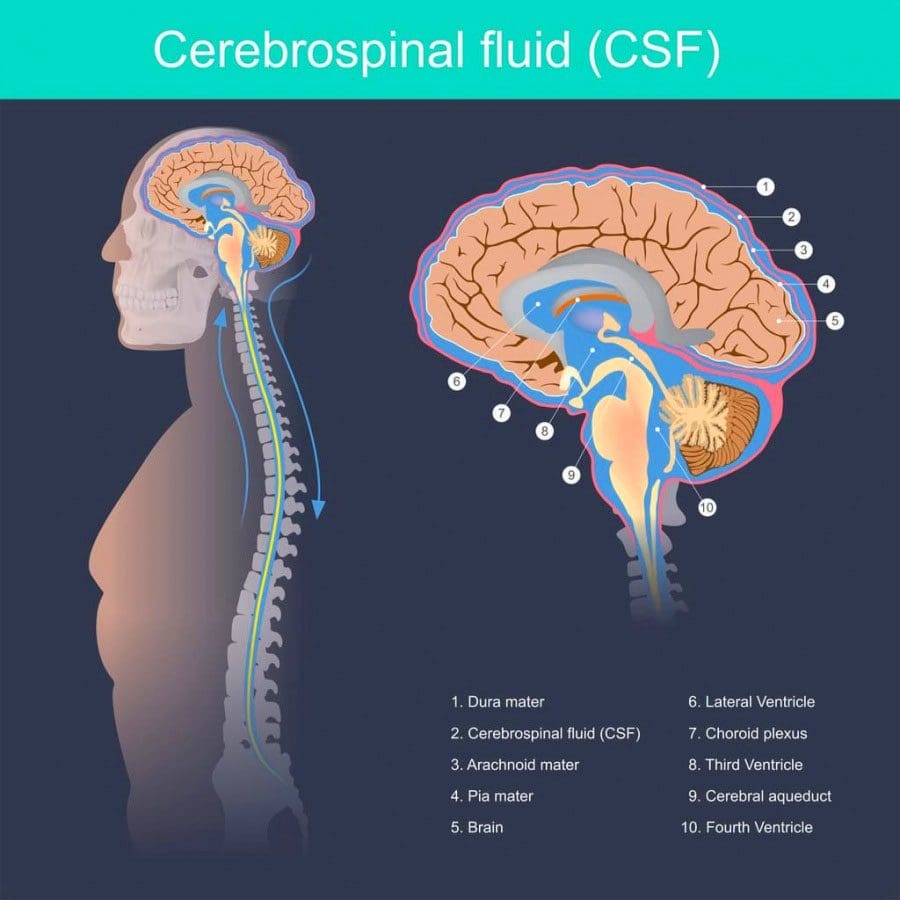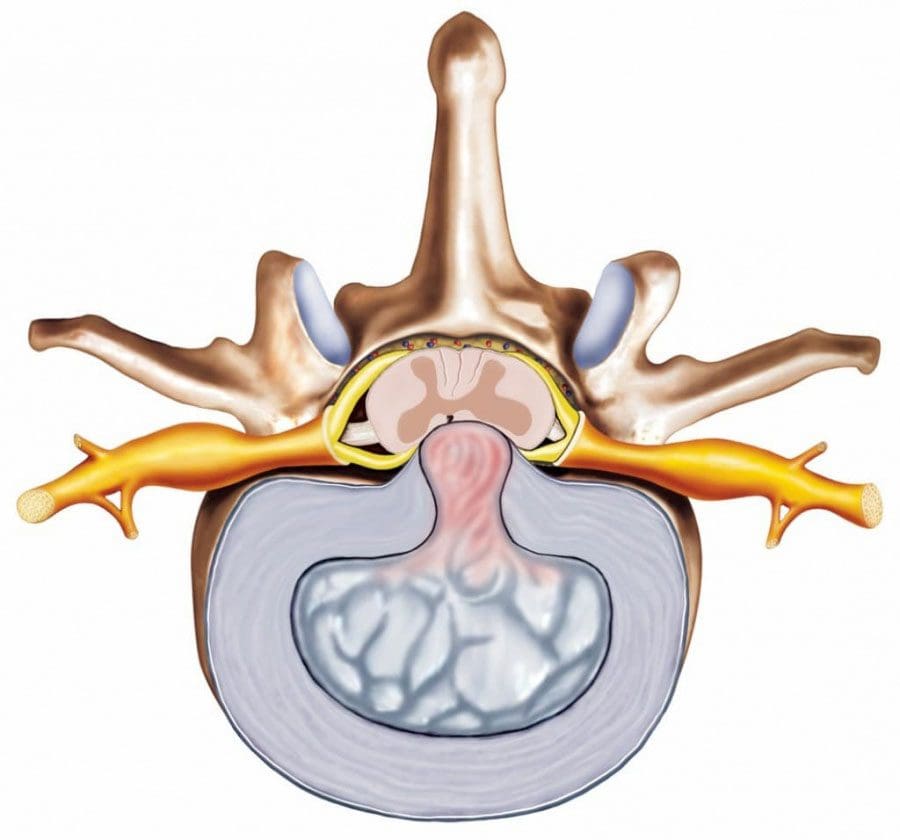With so much at stake, our bodies have developed a complex self-defense system to protect the spinal cord and its critical two-way�sensory information flow. As the body�s nerve center the spinal cord controls almost all voluntary and involuntary movements throughout the torso, arms, and legs.�It also receives sensory input from the torso and limbs. The�spinal cord plays a critical role and needs to be defended. The most prominent protection for the brain is the skull, for the spinal cord, it is more complicated.
Contents
Self Defense

The spinal cord consists of a bunch of nerves. One of the self-defenses is the cerebrospinal fluid (CSF) that cushions and nourishes them. On the outside, the spinal cord is protected by the tube structure known as the meninges. Three-layered membranes make up the meninges, each with its own protective role:
- Pia mater
- Arachnoid mater
- Dura mater
Self-defenses do not stop there. Another self-defense includes the vertebrae or the backbones themselves, intervertebral discs, and various muscles and ligaments.
Meninges
The meninges are three layers of membranes that encapsulate the spinal cord at the brainstem from the top to the bottom of the spine. The innermost layer is the pia mater and is attached directly to the spinal cord. It is made up of mostly collagen that has an elasticity that allows the cord to maintain its shape. Next comes the arachnoid mater and is the middle layer.
Its primary role is to maintain the cerebrospinal fluid that fills the subarachnoid space between the pia and the arachnoid. A common condition known as arachnoiditis involves the arachnoid mater. It is a painful inflammation of the membrane that requires medical treatment. It can lead to disability if it is progressive.
Dura Mater
The outer layer is the dura mater and is the toughest. The dura rests on the arachnoid with a small amount of fluid in-between. The epidural space separates this membrane from the wall of the vertebral canal. Although it is tough, tears can occur. Tears can result from:
- Injury
- Epidural injections
- Lumbar punctures
- Complications from spine surgery
Some individuals can even develop tears spontaneously, sometimes as a result of a connective tissue disorder. When the dura tears cerebrospinal fluid leaks out of the space, leaving the brain and spine with less cushion and support.
Postural headaches are worse standing than sitting or laying down and can be severe are the most common symptom of spinal fluid leaks. But these tears typically heal quickly with bed rest.
Cerebrospinal Fluid

Cerebrospinal fluid is the clear liquid that fills the space between the pia and the arachnoid. It is made in the brain�s ventricles with its primary function to protect and nourish the spinal cord and brain. The fluid also removes waste products from the brain. The fluid also plays a role in helping doctors diagnose disease/s.
If a doctor suspects a severe infection or disorder of the central nervous system, they perform a lumbar puncture or spinal tap. The fluid can also contain evidence of inflammation or infection from waste products that the central nervous system discarded into the fluid. A doctor inserts a needle between two vertebrae in the lower back to remove a small amount of cerebrospinal fluid. The fluid is sent to the lab and analyzed. Lumbar punctures can be used to diagnose conditions like:
- Infectious brain and spinal diseases like meningitis and encephalitis
- Nervous system disorders like multiple sclerosis and Guillain-Barr� syndrome
- Bleeding in/around the brain
- Brain tumors
To see how the fluid is moving diagnostic images are done by injecting dye know as myelography or radioactive substances known as cisternography into the subarachnoid space before imaging. Lumbar punctures can also be used to measure the pressure of the cerebrospinal fluid.
Vertebrae
There are 33 bones that make up the spine that forms a framework shaping the body and protecting the spine.�In a healthy spine, the neck vertebrae curve slightly inward called lordosis, while the middle vertebrae curves outward called kyphosis before meeting the low vertebrae curved inward. This makes the spinal cord flexible and balanced.
Each vertebra has a complex shape with a precise configuration determined by the location in the spine. Many conditions of the vertebrae involve nerves that get pinched/compressed as they exit the spine. Pinched nerves usually result from bone spurs on the vertebrae that crowd the canal and from herniated discs.
Intervertebral Discs

The intervertebral discs are the spine�s shock absorbers. They fill the space between two vertebrae with no direct contact. The endplates of each are coated with protective cartilage which anchors the discs in place. The gel substance part of each disc is called the nucleus pulposus. The tough cover known as the annulus fibrosus wraps around each disc to protect and shape it. There are no blood vessels in the discs and are nourished by the endplates of the vertebrae.
Herniated discs are the most common disc-related condition. When a disc herniates, the annulus fibrosus tears. The tear leaks out the protective gel to bulge out into the spinal canal. With no room in the canal for anything but the spinal cord and spinal fluid, the gel puts pressure on the surrounding nerve/s and the spinal cord itself. This is called myelopathy when the spinal cord gets compressed. Non-surgical treatments are quite successful in healing herniated disc/s.
The spine�s self-defense is elaborate, effective, and complicated. Consult an experienced spine specialist/chiropractor who can produce the best results and benefits.
Severe Back Pain Treatment
NCBI Resources
General Disclaimer, Licenses and Board Certifications *
Professional Scope of Practice *
The information herein on "Self-Defense System of The Spine" is not intended to replace a one-on-one relationship with a qualified health care professional or licensed physician and is not medical advice. We encourage you to make healthcare decisions based on your research and partnership with a qualified healthcare professional.
Blog Information & Scope Discussions
Welcome to El Paso's Premier Wellness and Injury Care Clinic & Wellness Blog, where Dr. Alex Jimenez, DC, FNP-C, a Multi-State board-certified Family Practice Nurse Practitioner (FNP-BC) and Chiropractor (DC), presents insights on how our multidisciplinary team is dedicated to holistic healing and personalized care. Our practice aligns with evidence-based treatment protocols inspired by integrative medicine principles, similar to those on this site and on our family practice-based chiromed.com site, focusing on naturally restoring health for patients of all ages.
Our areas of multidisciplinary practice include Wellness & Nutrition, Chronic Pain, Personal Injury, Auto Accident Care, Work Injuries, Back Injury, Low Back Pain, Neck Pain, Migraine Headaches, Sports Injuries, Severe Sciatica, Scoliosis, Complex Herniated Discs, Fibromyalgia, Chronic Pain, Complex Injuries, Stress Management, Functional Medicine Treatments, and in-scope care protocols.
Our information scope is multidisciplinary, focusing on musculoskeletal and physical medicine, wellness, contributing etiological viscerosomatic disturbances within clinical presentations, associated somato-visceral reflex clinical dynamics, subluxation complexes, sensitive health issues, and functional medicine articles, topics, and discussions.
We provide and present clinical collaboration with specialists from various disciplines. Each specialist is governed by their professional scope of practice and their jurisdiction of licensure. We use functional health & wellness protocols to treat and support care for musculoskeletal injuries or disorders.
Our videos, posts, topics, and insights address clinical matters and issues that are directly or indirectly related to our clinical scope of practice.
Our office has made a reasonable effort to provide supportive citations and has identified relevant research studies that support our posts. We provide copies of supporting research studies upon request to regulatory boards and the public.
We understand that we cover matters that require an additional explanation of how they may assist in a particular care plan or treatment protocol; therefore, to discuss the subject matter above further, please feel free to ask Dr. Alex Jimenez, DC, APRN, FNP-BC, or contact us at 915-850-0900.
We are here to help you and your family.
Blessings
Dr. Alex Jimenez DC, MSACP, APRN, FNP-BC*, CCST, IFMCP, CFMP, ATN
email: coach@elpasofunctionalmedicine.com
Multidisciplinary Licensing & Board Certifications:
Licensed as a Doctor of Chiropractic (DC) in Texas & New Mexico*
Texas DC License #: TX5807, Verified: TX5807
New Mexico DC License #: NM-DC2182, Verified: NM-DC2182
Multi-State Advanced Practice Registered Nurse (APRN*) in Texas & Multi-States
Multi-state Compact APRN License by Endorsement (42 States)
Texas APRN License #: 1191402, Verified: 1191402 *
Florida APRN License #: 11043890, Verified: APRN11043890 *
License Verification Link: Nursys License Verifier
* Prescriptive Authority Authorized
ANCC FNP-BC: Board Certified Nurse Practitioner*
Compact Status: Multi-State License: Authorized to Practice in 40 States*
Graduate with Honors: ICHS: MSN-FNP (Family Nurse Practitioner Program)
Degree Granted. Master's in Family Practice MSN Diploma (Cum Laude)
Dr. Alex Jimenez, DC, APRN, FNP-BC*, CFMP, IFMCP, ATN, CCST
My Digital Business Card
Licenses and Board Certifications:
DC: Doctor of Chiropractic
APRNP: Advanced Practice Registered Nurse
FNP-BC: Family Practice Specialization (Multi-State Board Certified)
RN: Registered Nurse (Multi-State Compact License)
CFMP: Certified Functional Medicine Provider
MSN-FNP: Master of Science in Family Practice Medicine
MSACP: Master of Science in Advanced Clinical Practice
IFMCP: Institute of Functional Medicine
CCST: Certified Chiropractic Spinal Trauma
ATN: Advanced Translational Neutrogenomics
Memberships & Associations:
TCA: Texas Chiropractic Association: Member ID: 104311
AANP: American Association of Nurse Practitioners: Member ID: 2198960
ANA: American Nurse Association: Member ID: 06458222 (District TX01)
TNA: Texas Nurse Association: Member ID: 06458222
NPI: 1205907805
| Primary Taxonomy | Selected Taxonomy | State | License Number |
|---|---|---|---|
| No | 111N00000X - Chiropractor | NM | DC2182 |
| Yes | 111N00000X - Chiropractor | TX | DC5807 |
| Yes | 363LF0000X - Nurse Practitioner - Family | TX | 1191402 |
| Yes | 363LF0000X - Nurse Practitioner - Family | FL | 11043890 |








